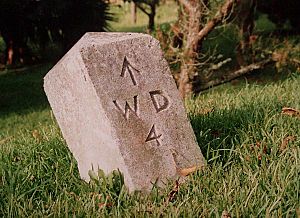War Department (United Kingdom) facts for kids

The War Department was a part of the United Kingdom government. Its main job was to make sure the UK's armed forces had all the equipment they needed. It also helped plan and carry out military actions. In 1857, this department changed its name to the War Office. Even after the name change, the term 'War Department' was still used for its military transport, like the War Department Fleet (ships) and the War Department Railways (trains).
Contents
What Was the War Department?
The War Department was a very important part of the British government. It made sure that soldiers, sailors, and airmen had everything they needed to do their jobs. This included weapons, uniforms, food, and transport. It also helped manage military activities around the world.
How Did the War Department Start?
The idea for the War Department began in 1794. At that time, a new job was created called the Secretary of State for War. This person was in charge of military matters. Their office was first unofficially known as the War Department.
Over time, its responsibilities changed. It sometimes handled colonial affairs (matters in British colonies). After a war with revolutionary France, it was called the Colony and War Department. In 1815, after peace returned, it became just the Colonial Department.
In February 1855, two important roles, the Secretary of State for War and the Secretary at War, were combined. This new combined department was once again called the War Department. However, this name only lasted until 1857, when it officially became the War Office. Much later, in 1964, the War Office became part of the larger Ministry of Defence.
War Department Railways: Trains for the Military
One interesting part of the War Department's work was providing trains and railway equipment. These trains were used in the United Kingdom, in other parts of the British Empire, and in places where conflicts were happening.
Trains in World War I
During World War I, the War Department ran special trains called the War Department Light Railways. These were narrow-gauge railways, often built right in the trenches. They were super important for moving supplies like ammunition and food. They also helped transport troops and bring injured soldiers away from the front lines.
Trains in World War II
In World War II, the War Department ordered many new steam locomotives (train engines). They also got some diesel locomotives. These trains came in different sizes to fit the railway tracks in various parts of the world where they would be used.
After the war ended, most of these military trains were sold to different railway companies around the globe. However, some were kept for use on military railways in the UK during peacetime. A few types of these 'Austerity' locomotives (meaning they were built simply and strongly for wartime) even became part of the British Railways fleet:
- Hunslet Austerity 0-6-0ST (BR numbers 68006–68080)
- WD Austerity Class 8F 2-8-0 (BR numbers 90000–90732)
- WD Austerity Class 8F 2-10-0 (BR numbers 90750–90774)
You can find more details about these trains on the Steam locomotives of British Railways page.
See also
- Broad arrow

